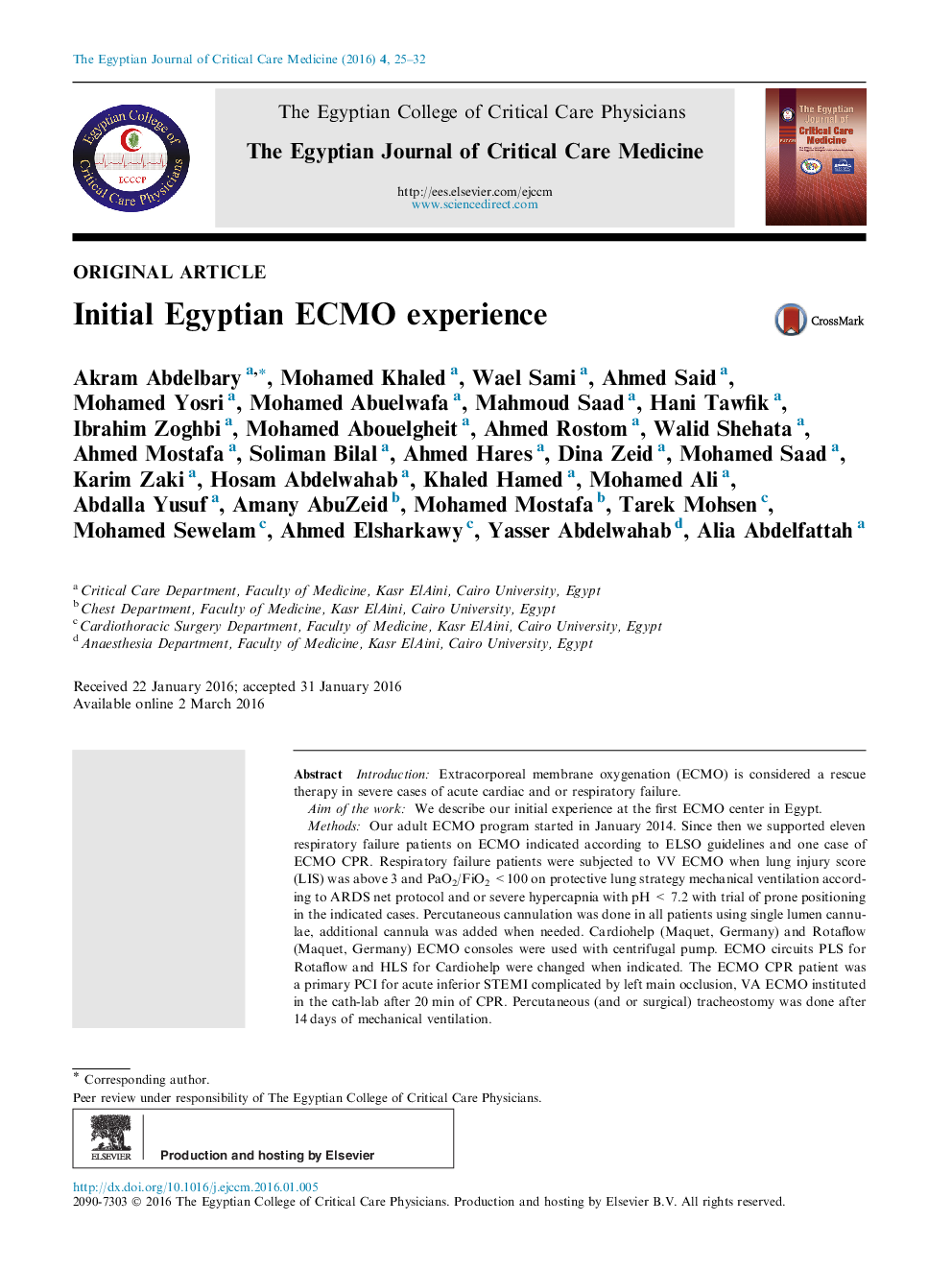| کد مقاله | کد نشریه | سال انتشار | مقاله انگلیسی | نسخه تمام متن |
|---|---|---|---|---|
| 2910885 | 1575309 | 2016 | 8 صفحه PDF | دانلود رایگان |
IntroductionExtracorporeal membrane oxygenation (ECMO) is considered a rescue therapy in severe cases of acute cardiac and or respiratory failure.Aim of the workWe describe our initial experience at the first ECMO center in Egypt.MethodsOur adult ECMO program started in January 2014. Since then we supported eleven respiratory failure patients on ECMO indicated according to ELSO guidelines and one case of ECMO CPR. Respiratory failure patients were subjected to VV ECMO when lung injury score (LIS) was above 3 and PaO2/FiO2 <100 on protective lung strategy mechanical ventilation according to ARDS net protocol and or severe hypercapnia with pH < 7.2 with trial of prone positioning in the indicated cases. Percutaneous cannulation was done in all patients using single lumen cannulae, additional cannula was added when needed. Cardiohelp (Maquet, Germany) and Rotaflow (Maquet, Germany) ECMO consoles were used with centrifugal pump. ECMO circuits PLS for Rotaflow and HLS for Cardiohelp were changed when indicated. The ECMO CPR patient was a primary PCI for acute inferior STEMI complicated by left main occlusion, VA ECMO instituted in the cath-lab after 20 min of CPR. Percutaneous (and or surgical) tracheostomy was done after 14 days of mechanical ventilation.ResultsA total of twelve patients received ECMO between January 2014 and June 2015. The mean age was 35.9 years. (range 13–65 years), 8 males, with VV ECMO in 10 patients, and VA ECMO in 2 patients. Out of ten patients of VV ECMO, one had H1N1 pneumonia, one had advanced vasculitic lung, four had bacterial pneumonia, two traumatic lung contusions and one with organophosphorus poisoning, and one undiagnosed etiology leading to severe ARDS. Lung injury score range was 3–3.8, PaO2/FiO2 (20–76) mechanical ventilation duration before ECMO 1–14 days, Femoro-jugular cannulation in 7 patients and femoro-femoral in 2 patients and femoro-subclavian in 1 patient; all patients were initially sedated and paralyzed for (2–4 days) and ventilated on pressure controlled ventilation with Pmax of 25 cm H2O and PEEP of 10 cm H2O. In VA ECMO patients were cannulated percutaneously using femoro-femoral approach. One patient showed no neurologic recovery and died after 24 h, the other had CABG on ECMO however the heart didn’t recover and died after 9 days. Heparin intravenous infusion was used initially in all patients and changed to Bivalirudin in 2 patients due to possible HIT. Pump flow ranged from 2.6 to 6.5 L/min. Average support time was 12 days (range 2–24 days). Seven patients (63.3%) were successfully separated from ECMO and survived to hospital discharge. Hospital length of stay ranged from 3 to 42 days, tracheostomy was done percutaneously in 5 patients and surgically in 3. Gastrointestinal bleeding occurred in 6 patients, VAP in 7 patients, neurologic complications in 1 patient with complete recovery, cardiac arrhythmias in 3 patients, pneumothorax in 9 patients, and deep venous thrombosis in 2 patients.
Journal: The Egyptian Journal of Critical Care Medicine - Volume 4, Issue 1, April 2016, Pages 25–32
